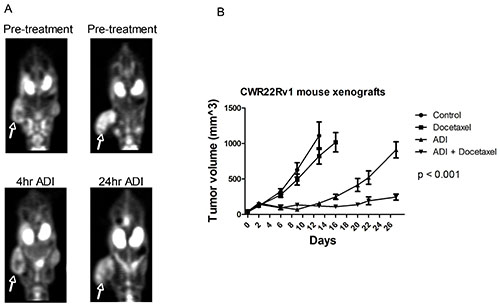


Posted September 24, 2013
Richard Bold, M.D., Frank Y. S. Chuang, Ph.D., and Hsing-Jien Kung, Ph.D., University of California at Davis
 Dr. Richard Bold's, lab, along with his collaborators Drs. Frank Chuang and Jien Kung, at the University of California at Davis is in pursuit of novel therapies for advanced prostate cancer. Building on promising results for a lymphoma treatment, they evaluated the potential of targeting metabolic pathways for new therapies in prostate cancer, focusing specifically on the creation and break-down of the amino acid, arginine. The research supported by his FY07 PCRP Idea Development Award found that some prostate cancers are deficient in a key enzyme involved in the synthesis of arginine, making them dependent on obtaining arginine from extracellular sources to prevent cell nutrient starvation. His group further found that when this extracellular arginine is degraded by arginine deiminase (ADI), the prostate cancer cells die as a result of metabolic stress. This toxic effect of ADI can be further augmented by treatment with paclitaxel, a standard chemotherapy in prostate cancer.
Dr. Richard Bold's, lab, along with his collaborators Drs. Frank Chuang and Jien Kung, at the University of California at Davis is in pursuit of novel therapies for advanced prostate cancer. Building on promising results for a lymphoma treatment, they evaluated the potential of targeting metabolic pathways for new therapies in prostate cancer, focusing specifically on the creation and break-down of the amino acid, arginine. The research supported by his FY07 PCRP Idea Development Award found that some prostate cancers are deficient in a key enzyme involved in the synthesis of arginine, making them dependent on obtaining arginine from extracellular sources to prevent cell nutrient starvation. His group further found that when this extracellular arginine is degraded by arginine deiminase (ADI), the prostate cancer cells die as a result of metabolic stress. This toxic effect of ADI can be further augmented by treatment with paclitaxel, a standard chemotherapy in prostate cancer.
One of the biggest obstacles impeding the movement of a promising treatment from basic discovery to the clinic for patient use is finding support for the necessary preclinical studies. With his funding from the PCRP, Dr. Bold was able to conduct early pre-clinical studies of ADI therapy in animal models, demonstrating proof-of-principle results for the efficacy of ADI treatment and providing evidence to support pursuing studies in humans. To move this treatment towards clinical use, Dr. Bold has now begun a Phase I/II clinical trial to test the safety of the ADI/paclitaxel combination therapy and determine the tolerable doses of both agents in humans. To date, enrollment for the trial is approximately 50% complete, and Dr. Bold anticipates completion of the clinical trial within the next year with future plans to move forward with a Phase III trial toward making this novel approach available to prostate cancer patients.















